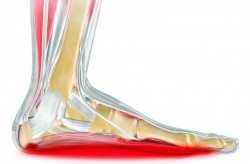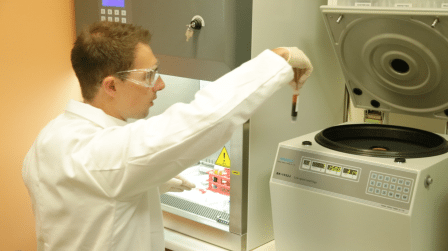Platelet Rich Plasma
by Dr James Ferrie (Musculoskeletal and Sports Podiatrist)
 Plantar fasciitis is debilitating and often frustrating condition of the heel, which affects approximately 10% of the population at some stage. The plantar fascia is a form of ligament, which inserts in to the base of the heel and extends to all the toes. It is a vital structure of the foot, which aids in maintaining the arch and transferring weight from the hind-foot to the forefoot during walking and running. Plantar fasciitis is a repetitive overuse condition, which results in a degenerative change of the plantar fascia at its insertion into the heel bone.
Plantar fasciitis is debilitating and often frustrating condition of the heel, which affects approximately 10% of the population at some stage. The plantar fascia is a form of ligament, which inserts in to the base of the heel and extends to all the toes. It is a vital structure of the foot, which aids in maintaining the arch and transferring weight from the hind-foot to the forefoot during walking and running. Plantar fasciitis is a repetitive overuse condition, which results in a degenerative change of the plantar fascia at its insertion into the heel bone.
The term plantar “fasciitis” is misleading, the “itis’ infers the condition is inflammatory yet recent evidence from biopsy’s of the plantar fascia during surgery for chronic plantar fasciitis find no evidence of inflammatory cells and concludes that there is a disorganised degenerative change to the fascia (Lemont, Ammirati & Usen, 2003). This change results in biomechanical and biochemical changes in the tissue affecting its ability to withstand the forces required for day-to-day activity and exercise. These changes can often explain why rest, anti-inflammatory medication and cortisone injection provide little relief in the more chronic cases.
 In chronic cases, that haven’t responded to conservative physical therapy doctors and healthcare providers, often recommend a cortisone injection as a last ditch effort to reduce the patients pain. Cortisone is a potent suppressor of the immune system and tissue repair process and when injected into a tendon or fascia it results in the weakening of the structure and increases the risk of rupture and tearing. The evidence for its use in plantar fasciitis is questionable. A recent study comparing cortisone injection to a saline placebo injection only found a benefit in pain reduction for the first 4 weeks. Beyond this it was found to be no more effective than saline (McMillan et al., 2012). Cortisone is at best a short-term band-aide, which often gives patients a false sense of recovery, masking the pain and allowing further damage to occur.
In chronic cases, that haven’t responded to conservative physical therapy doctors and healthcare providers, often recommend a cortisone injection as a last ditch effort to reduce the patients pain. Cortisone is a potent suppressor of the immune system and tissue repair process and when injected into a tendon or fascia it results in the weakening of the structure and increases the risk of rupture and tearing. The evidence for its use in plantar fasciitis is questionable. A recent study comparing cortisone injection to a saline placebo injection only found a benefit in pain reduction for the first 4 weeks. Beyond this it was found to be no more effective than saline (McMillan et al., 2012). Cortisone is at best a short-term band-aide, which often gives patients a false sense of recovery, masking the pain and allowing further damage to occur.
Platelet rich plasma (PRP) is an exciting emerging treatment approach, which is showing long-term benefits for patients suffering chronic plantar fasciitis. The PRP is obtained from the patient’s own blood just like having a blood test. The blood is then spun in a centrifuge and the plasma, platelets and white blood cells are careful removed. This is then concentrated further and activated to release the growth factors found within the platelets. Finally the concentrated PRP is re-injected into the injured area, under ultrasound guidance to ensure accurate placement. When PRP is injected into the damaged degenerative plantar fascia it “switches on” adult cell stems and stimulates fibroblasts cells to synthesise new collagen to strengthen and regenerate the plantar fascia. White blood cells also enter the area to “mop up” any damaged non-viable tissue that may be the cause of ongoing pain and stagnation in the healing process. Monto 2014 studied a single PRP injection in comparison to a cortisone injection to treat chronic plantar fasciitis, which had failed at least 4 months of conservative treatment. He concluded, “PRP was more effective and durable than a cortisone injection for the treatment of chronic recalcitrant cases of plantar fasciitis” (Monto, 2014). This treatment unlike standard drug based approaches utilises the body’s endogenous growth factors to stimulate a natural repair and regeneration process. TFAAC maximises the results and accuracy of this treatment by providing all PRP injections under sterile conditions using Ultrasound Guidance.
References
Lemont, H., Ammirati, K., & Usen, N. (2003). Plantar Fasciitis. Journal Of The American Podiatric Medical Association, 93(3), 234-237. doi:10.7547/87507315-93-3-234
McMillan, A., Landorf, K., Gilheany, M., Bird, A., Morrow, A., & Menz, H. (2012). Ultrasound guided corticosteroid injection for plantar fasciitis: randomised controlled trial. BMJ, 344(may22 1), e3260-e3260. doi:10.1136/bmj.e3260
Monto, R. (2014). Platelet-Rich Plasma Efficacy Versus Corticosteroid Injection Treatment for Chronic Severe Plantar Fasciitis. Foot & Ankle International, 35(4), 313-318. doi:10.1177/1071100713519778

